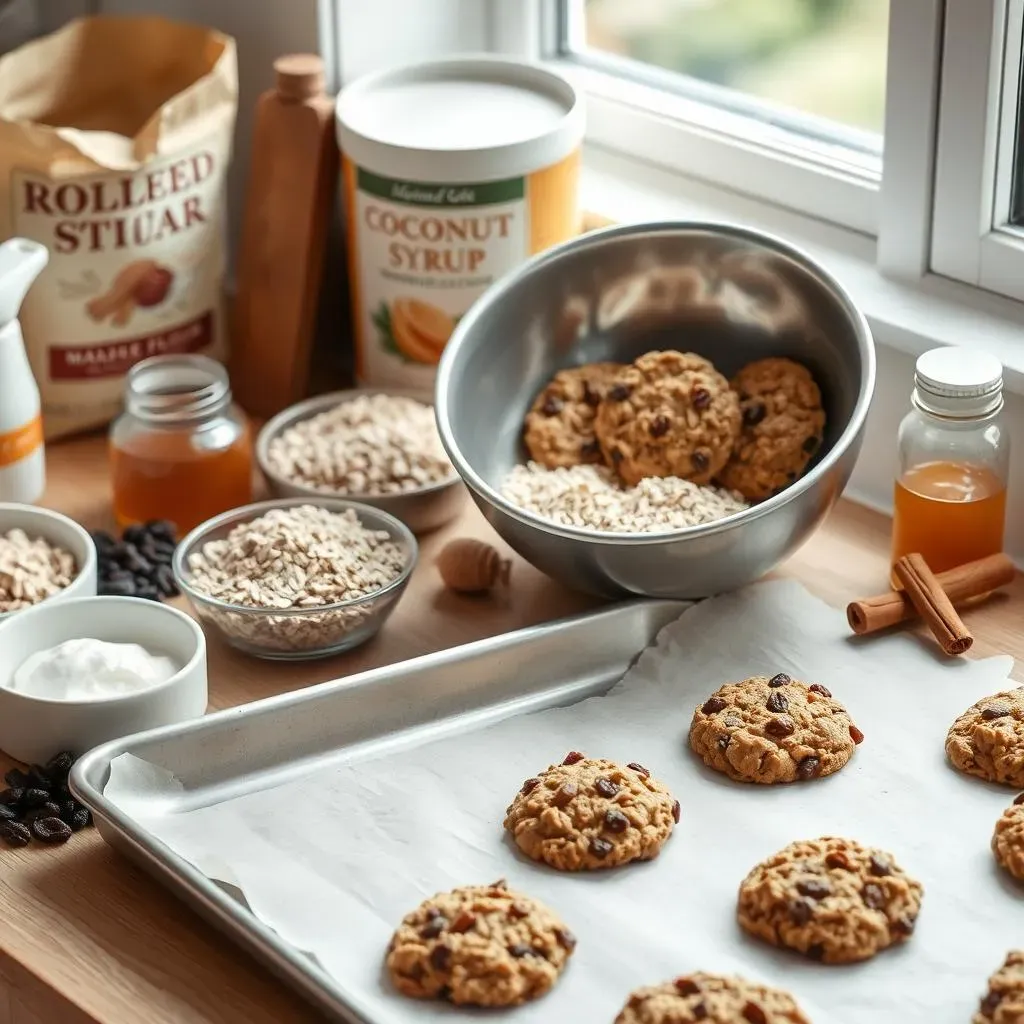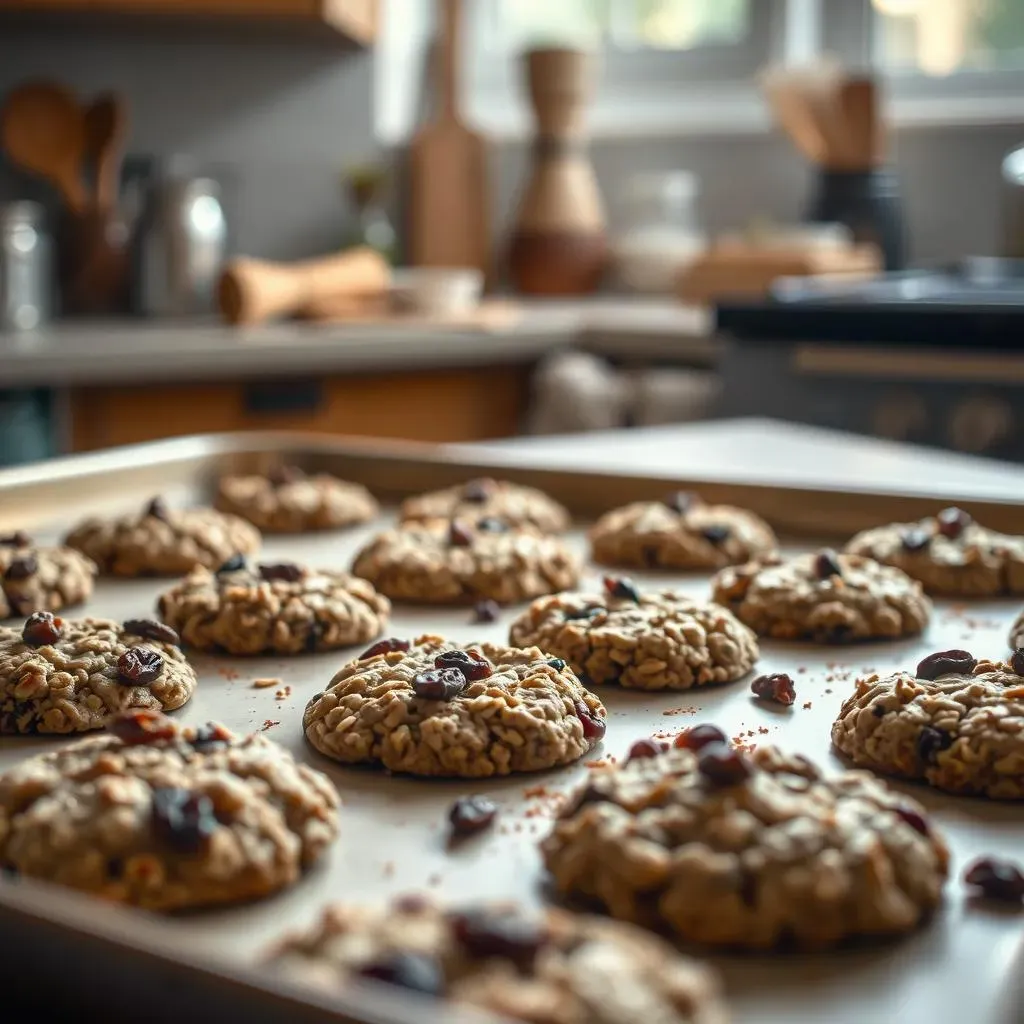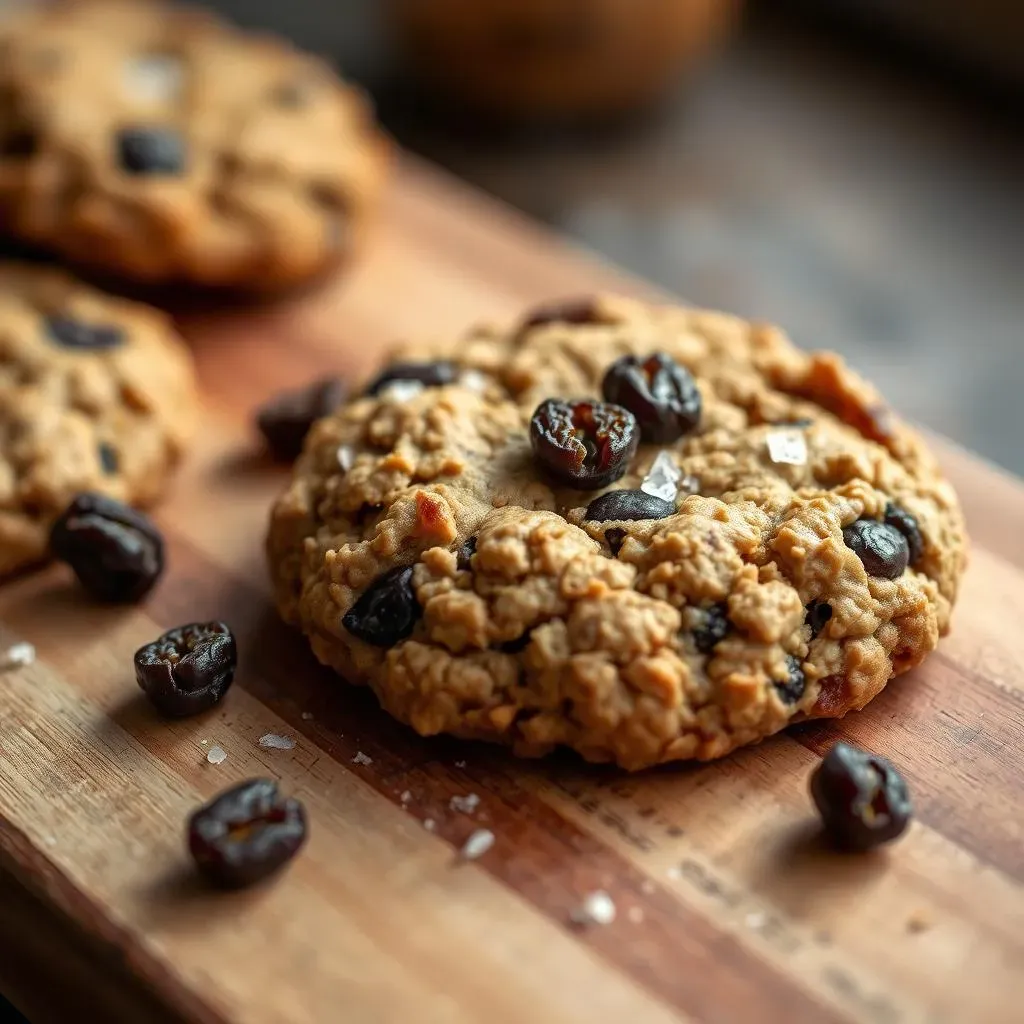Table of Contents
Who says you can't have your cookie and eat it too? If you're anything like me, the words "oatmeal raisin" might conjure up images of dense, overly sweet treats. But what if I told you that you could enjoy the comforting flavors of this classic cookie with a fraction of the fat? That's right, we're talking about delicious, chewy, and satisfying lower fat oatmeal raisin cookies. This isn't about depriving yourself, it's about smart swaps that let you indulge without the guilt. In this article, I'll guide you through the secrets of making these healthier cookies, covering everything from ingredient selection to baking tips. We will explore why choosing lower fat options can be beneficial and dive into the key components that make these cookies both nutritious and delicious. I'll share my step-by-step method for baking these little wonders and offer some insider tips to ensure your cookies turn out perfectly every time. Get ready to bake your way to a healthier treat with these amazing lower fat oatmeal raisin cookies!
Why Choose Lower Fat Oatmeal Raisin Cookies?

Why Choose Lower Fat Oatmeal Raisin Cookies?
The Guilt-Free Treat
Let's face it, we all love a good cookie, but sometimes the guilt that follows isn't so sweet. Traditional oatmeal raisin cookies can be loaded with butter and oil, making them a less-than-ideal snack if you're watching your fat intake. That's where lower fat oatmeal raisin cookies come to the rescue. They offer that same comforting taste and texture we crave, but with smart ingredient swaps that significantly reduce the fat content. It’s about making choices that allow you to enjoy your favorite treats without compromising your health goals. These cookies are my go-to when I want a little something sweet without feeling like I've completely derailed my day.
Health Benefits Beyond the Fat
It's not just about cutting fat, it’s also about what you gain. Lower fat oatmeal raisin cookies, when made right, can be a source of fiber from the oats, which helps keep you full and aids digestion. Plus, raisins add a touch of natural sweetness and antioxidants. Unlike many store-bought options that are packed with processed ingredients, making your own allows you to control what goes into them. You can choose whole grains, unrefined sugars, and even add extra goodies like nuts or seeds for an added nutritional boost. It's about making a snack that actually does something good for your body, not just your taste buds. I mean, who doesn't want a cookie that's practically a health food? Okay, maybe not *practically*, but you get my point.
Nutrient | Benefits |
|---|---|
Fiber (from oats) | Aids digestion, promotes fullness |
Antioxidants (from raisins) | Combats free radicals, supports overall health |
Complex Carbohydrates (from oats) | Provides sustained energy |
A Smart Swap for Everyone
Whether you're aiming to manage your weight, reduce your saturated fat intake, or simply make healthier choices, lower fat oatmeal raisin cookies are a fantastic alternative. They are a great option for families looking to cut back on unhealthy fats without sacrificing flavor, and for those of us who love to bake but also want to be mindful of our health. I’ve found that introducing these kinds of swaps into my diet makes a huge difference in how I feel and keeps me from feeling deprived. Plus, they are a fun baking project for anyone, even if you are new to the kitchen. It's about making small, sustainable changes that add up to a big impact, and these cookies? They're a pretty sweet place to start.
Key Ingredients for Lower Fat Oatmeal Raisin Cookies

Key Ingredients for Lower Fat Oatmeal Raisin Cookies
The Foundation: Oats and Flour
Let's start with the basics: oats and flour. For lower fat oatmeal raisin cookies, you'll want to use rolled oats, not the instant kind. Rolled oats give a great chewy texture that's just perfect for these cookies. As for flour, whole wheat flour is my go-to because it adds more fiber and nutrients compared to all-purpose flour. However, if you don't have any on hand, all-purpose flour will work just fine too. The key here is to get a good balance. Don't be afraid to experiment with a mix of the two to find what you like best. It's all about building that sturdy base for our cookies.
I remember the first time I tried using whole wheat flour, I was surprised by how much it improved the texture. It gives a slightly nutty flavor that pairs so well with the oats and raisins. It was a game-changer for my baking.
Sweetness and Moisture: Smart Swaps
Next up is sweetness and moisture, and this is where we make some crucial lower-fat swaps. Instead of relying entirely on butter, we’re going to use a small amount of coconut oil or a light butter substitute. Just a couple tablespoons is usually enough to keep the cookies moist without adding excess fat. For sweetness, I like to use honey or maple syrup instead of refined sugars. These natural sweeteners not only add a lovely flavor but also have a lower glycemic index, which can be gentler on your blood sugar. It’s about making choices that are better for you without sacrificing taste.
One time I tried using applesauce to add moisture, and it worked pretty well! It's all about trying new things and seeing what works best for you.
Ingredient | Why it's Important | Lower Fat Swap |
|---|---|---|
Butter | Adds richness and moisture | Coconut Oil or Light Butter Substitute |
Refined Sugar | Adds sweetness | Honey or Maple Syrup |
All-Purpose Flour | Provides structure | Whole Wheat Flour (or a mix) |
The Flavor Boosters: Raisins and Spices
Finally, let's talk about the flavor boosters: raisins and spices. Obviously, we can't have oatmeal raisin cookies without the raisins! I like to soak mine in warm water for a few minutes before adding them to the dough, which makes them plump and juicy. As for spices, cinnamon is a must, but you can also add a pinch of nutmeg or ginger for extra warmth. These spices not only enhance the flavor but also add a touch of coziness to the cookies. It’s the little things that make all the difference. Don't be shy about experimenting with different spice combinations; it's a fun way to make the recipe your own.
I once added a tiny bit of cardamom to my cookies and it gave them a really unique and delicious twist. It's all about finding those small details that make your cookies special.
StepbyStep Guide to Baking Lower Fat Oatmeal Raisin Cookies

StepbyStep Guide to Baking Lower Fat Oatmeal Raisin Cookies
Getting Started: Prep Work
Alright, let’s get baking! First things first, you'll want to preheat your oven to 350°F (175°C). While the oven is heating up, grab a large bowl and toss in your rolled oats, whole wheat flour (or all-purpose, if that's what you're using), cinnamon, and any other spices you're adding. Give it a good mix to make sure everything is evenly distributed. In a separate bowl, mix together your melted coconut oil (or light butter substitute), honey or maple syrup, and vanilla extract. This wet mixture is going to bring everything together. Don't forget to soak those raisins in warm water for a few minutes; this step is a game-changer for plumpness.
I always set up my ingredients beforehand; it makes the whole process so much smoother and less chaotic. It's like having your own little baking mise en place, which makes you feel like a pro, even if you're just making cookies.
Mixing and Chilling: The Key to Success
Now, pour your wet ingredients into the bowl with the dry ingredients. Mix everything together until just combined. Be careful not to overmix; you want the dough to be just combined, not tough. Gently fold in those plumped-up raisins. Once everything is mixed, cover the bowl and pop it into the fridge for about 30 minutes. This chilling step is crucial because it helps the dough firm up, making it easier to handle and preventing your cookies from spreading too much during baking. Trust me, this little bit of patience pays off big time.
I remember one time, I skipped the chilling step because I was in a rush, and my cookies came out flat and sad. Lesson learned! Now, I never skip the chill time; it makes all the difference.
Step | Action | Why it Matters |
|---|---|---|
1 | Preheat oven to 350°F (175°C) | Ensures even baking |
2 | Combine dry ingredients | Evenly distributes spices |
3 | Mix wet ingredients | Creates a cohesive base |
4 | Combine wet and dry ingredients | Forms cookie dough |
5 | Chill dough for 30 minutes | Prevents spreading |
Baking and Cooling: The Final Touches
After the dough has chilled, take it out of the fridge and use a spoon or cookie scoop to place rounded tablespoons of dough onto a baking sheet lined with parchment paper. Leave a little space between each cookie, as they will spread a bit as they bake. Pop the baking sheet into the preheated oven and bake for 10-12 minutes, or until the edges are golden brown and the centers are set. Keep a close eye on them, as oven temperatures can vary. Once they're done, take them out and let them cool on the baking sheet for a few minutes before transferring them to a wire rack to cool completely. This cooling time is important, as the cookies will continue to set as they cool. Then, enjoy your delicious, lower fat oatmeal raisin cookies!
I always find the smell of baking cookies so comforting. It's like a little hug in the form of deliciousness. And the best part is that you made them yourself, and they are better for you too!
Tips and Tricks for Perfect Lower Fat Oatmeal Raisin Cookies

Tips and Tricks for Perfect Lower Fat Oatmeal Raisin Cookies
Mastering the Dough
Okay, so you've got your ingredients prepped and ready to go, but a few tweaks can take your cookies from good to great. First off, don't be shy about adjusting the liquid. If your dough seems too dry, add a teaspoon of water or milk at a time until it reaches the right consistency. The dough should be moist but not sticky. Also, when you're adding the raisins, make sure they're evenly distributed throughout the dough. You don't want one cookie to be a raisin bomb and another to be completely raisin-free. A good fold after adding the raisins will help with this. And remember, chilling the dough isn't just a suggestion; it’s a must! It prevents the cookies from spreading too much and helps them retain their shape.
I’ve definitely had my share of overly dry or unevenly raisin-ed cookies, so trust me on these tips. It's all about paying attention to the details!
Baking to Perfection
Now, let’s talk baking. Oven temperatures can vary, so keep a close eye on your cookies. You want the edges to be golden brown, but the centers should still be soft. Overbaking can result in dry, crunchy cookies, and nobody wants that. Another tip is to use parchment paper. It prevents the cookies from sticking to the baking sheet and makes cleanup a breeze. Also, don't overcrowd the baking sheet. Give each cookie enough space so they don't bake together. It's a small thing, but it makes a big difference in the final product. And remember, let them cool on the baking sheet for a few minutes before transferring them to a wire rack. This allows them to set properly.
I once made a batch where I didn't use parchment paper and oh boy, what a mess. Never again! It's always the little things that make the biggest impact.
Tip | Why It's Important |
|---|---|
Adjust liquid as needed | Ensures proper dough consistency |
Distribute raisins evenly | Guarantees consistent flavor |
Chill the dough | Prevents over-spreading |
Use parchment paper | Prevents sticking |
Don't overbake | Keeps cookies soft and chewy |
Storage and Variations
Once your cookies are completely cool, store them in an airtight container at room temperature. They'll stay fresh for about a week, if they last that long! If you’re looking to switch things up, there are tons of variations you can try. For a gluten-free option, use gluten-free certified oats and a gluten-free flour blend. For a vegan option, substitute the honey or maple syrup with agave or another plant-based sweetener. You can also add in other goodies like chopped nuts, seeds, or even a few chocolate chips for a little extra indulgence. The possibilities are endless, so don't be afraid to experiment and make these cookies your own!
I love adding a sprinkle of sea salt on top of my cookies right before baking; it gives them a perfect sweet-and-salty balance. It's those little touches that make your baking unique.
